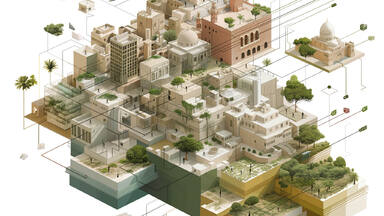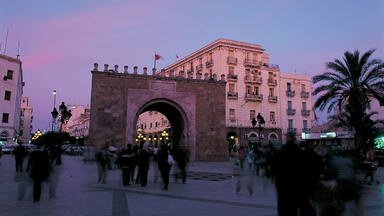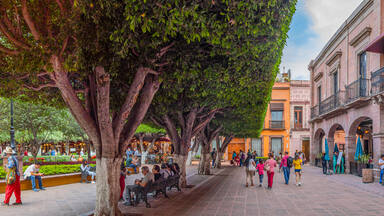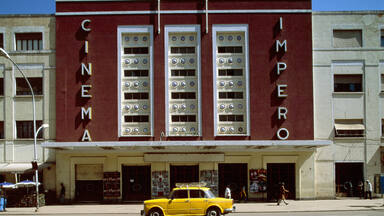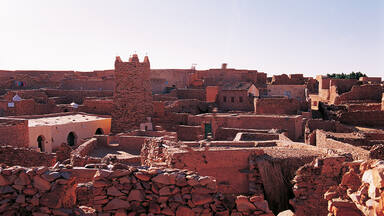This is:
-
An atlas of the World's historic cities and settlements
- A technical aid for implementing the 2011 HUL Recommendation
- A platform for cultural mapping and urban heritage
- A resource for education, capacity building, and participation
An atlas
The Urban Heritage Atlas is an atlas and an archive that documents and explains, visually, narratively and with analytical maps, the diversity and uniqueness of the world's historic cities and settlements. As such, it serves as a repository of city-building practices and new developments over time, as well as across the diverse regions of the world. This also includes vernacular architecture and traditional building techniques. While many collections and publications on World Heritage cities have been produced through the years, the diverse attributes and dimensions of World Heritage properties in urban contexts, and urban heritage in general, remain inadequately understood and threatened by a rapidly urbanising world. Urban heritage is often imagined as a collection of monuments and managed in an isolated way disconnected from holistic urban dynamics. This resource aims to fill this gap.
A technical aid
The Urban Heritage Atlas is technical aid for the implementation of the 2011 UNESCO Recommendation on the Historic Urban Landscape (HUL Recommendation), an instrument that provides a framework and approach for integrating heritage conservation with urban development plans and processes. As it makes the different layers of heritage visible, it supports better management of the historic urban area, ensuring that new projects and interventions are compatible with its heritage values. The HUL approach is a way of understanding urban heritage as part of a landscape or system composed of different elements and layers. It is not a category of cultural landscape nor a type of site. The Urban Heritage Atlas will be supported by the Managing Urban Heritage (currently under preparation), a resource manual and a guide for the implementation of the HUL Recommendation.
A cultural mapping platform
The Urban Heritage Atlas is also a cultural mapping platform that supports the identification and documentation of the specific attributes of historic cities and settlements that have a unique heritage value and should be conserved. For local (and national) authorities, this platform helps recognise what should be protected in a historic city or settlement and thus helps with better management of historic urban areas. It supports mapping the Urban Heritage values (UHV) and attributes that express the Outstanding Universal Value (OUV) of the World Heritage property at different scales. Cultural mapping is a methodology that makes visible the spatial relationships and built forms, cultural resources and practices and national features that make historic cities and settlements distinctive and meaningful. It supports those cities and settlements that are a part of or have properties inscribed on the UNESCO World Heritage List as well as all others not yet inscribed on the World Heritage List, including those on the national Tentative Lists (sites that may be eventually considered for nomination to the World Heritage List).
A learning resource
Finally, the Urban Heritage Atlas advances the understanding and awareness of urban heritage as well as educates and builds capacities. It invites and enables the participation of all stakeholders to enable informed decision-making around conservation as well as new interventions and projects toward better management of urban heritage.
Atlas of historic cities and settlements
Browse:
Join the Atlas
Urban Heritage Atlas: is a growing platform of urban heritage studies. If you are a city or settlement and would like to join the Atlas. Please, use the digital form and provide the information. The form works on computers and mobile phones to gather georefernced data.
For support, please contact: Heritage4Cities@unesco.org
What is the approach of the Recommendation on the Historic Urban Landscape?
Today, more than 70% of cultural World Heritage sites are located in urban areas, making them vulnerable to the pressure of urbanisation. To support State Parties in the conservation and management of their urban heritage, UNESCO Member States have adopted the 2011 Recommendation on the Historic Urban Landscape (HUL Recommendation), and the World Heritage Committee has established a thematic programme, the World Heritage Cities Programme.
Adopted by UNESCO's General Conference on 10 November 2011, the HUL Recommendation promotes a landscape approach for identifying and managing urban heritage. It is a vital tool to manage heritage in its wider setting.
"The HUL Recommendation advocates an approach that:
- Integrates heritage conservation with urban development plans and processes.
- Regards built heritage, natural environment, and the local communities and their intangible practices to be integrally related.
- Views urban heritage as a resource for sustainable development and resileience."
Did you know?
The Historic Urban Landscape represents a way of understanding urban heritage as part of a landscape or system composed of different elements and layers. It is not a category of cultural landscape nor a type of site.
How is urban heritage conservation different from the conservation of monuments?
The way that cultural heritage is identified, conserved and managed has evolved over time. From a focus on monuments and outstanding buildings, heritage conservation has expanded to other types and categories, such as cultural landscapes, intangible cultural heritage and vernacular settlements. This evolution is accompanied by a growing understanding of the potential of cultural heritage to contribute to sustainable development and climate resilience. The approach to urban heritage conservation is not about material or structural preservation and restoration as much as it is about planning, policies, laws, and regulations.
Urban heritage and sustainable development
Conserving urban heritage as a central element of the sustainable development of a city can improve its liveability, foster economic development and social cohesion, and help achieve a balance between urban growth and quality of life. This was reflected in the UN 2030 Agenda for Sustainable Development and the Sustainable Development Goals (SDGs).
Goal 11: Make cities and human settlements inclusive, safe, resilient and sustainable.
Target 11.4: Strengthen efforts to protect and safeguard the world's cultural and natural heritage.
To understand better the relationship of heritage with sustainable development at the local level.
See the World Heritage Canopy Platform
Conserving World Heritage cities
World Heritage properties in urban contexts are slightly overrepresented in Reactive Monitoring processes, which indicates that potential threats have been identified. 55% of World Heritage cities (175) have undergone Reactive Monitoring.
Urban development in World Heritage properties
Rapid and uncontrolled urbanisation is affecting the conservation of different types of World Heritage properties. Factors related to buildings and development (commercial development, housing, industrial area, and visitor facilities, major visitor accommodation and associated infrastructure) are present in nearly half of the properties that have gone on Reactive Monitoring; they are present in 37.5% of the SoC reports presented to the World Heritage Committee.
Methodology for the Urban Heritage Atlas and the mapping
The urban heritage studies presented here are the product of a collaborative process of research, reflection and analysis. The mapping and narrative were developed according to their urban layering and urban processes, including information on living dimensions, following the approach and the methodology of the HUL Recommendation. The material is showcased in a consistent, thorough way through plans, drawings and photographs of each site to give a holistic vision of each property.
The information presented in this platform has been compiled through 2 different methods:
1. Identification of attributes of the Outstanding Universal Value and Urban Heritage Values
In the first stage, the secretariat supports local authorities in compiling and analysing the Statement of Outstanding Universal Value of each of the properties (as the pilots were World Heritage properties), as well as relevant World Heritage Committee Decisions and World Heritage Nomination dossiers preserved at the UNESCO archive. The attributes that convey the OUV of the site were identified in each of the scales applying the framework developed in Managing Urban Heritage:
- Historic building attributes: building typologies, architectural styles, ornamentation, construction details and materials.
- Attributes of Urban elements: patterns, infrastructure, historic areas, built-up density, balance of open and built spaces, etc.
- Attributes of the wider setting of a city or settlement: geographic setting, scenic views, natural elements that determine the shape and the lifestyle of the city, etc.
- Intangible heritage values: traditions, gastronomy, festivals, creative practices.
2. Capacity-building exercises and reflection of local authorities and communities
Another essential effort in developing this work has been the direct exchanges with national and local stakeholders, such as the site managers of the World Heritage properties located in the cities presented, local experts or National Focal Points for World Heritage. The cases in this platform have been further expanded, adding local values, layers and attributes significant for local communities and supporting the OUV. This cooperative work was conducted through:
- A digital tool for providing such local information has been developed. See the link to the online form above.
- A short questionnaire was shared with local stakeholders for self-analysis and identification of local heritage values and attributes.
- The forms have been supplemented with other modalities.
Contact us
You can reach out to us at Heritage4Cities@unesco.org.
Disclaimer:
This platform not only presents the results of the exercises conducted with the cities in the collection but also encourages other cities to conduct similar analyses to identify better and recognise their universal and local values and attributes. Consequently, this is not a closed collection of "best of" but a growing platform. All interested cities are invited to contact the World Heritage Cities Programme team and develop their own case studies.
The cases shared in this platform address both OUV and Urban Heritage Values in World Heritage properties or other historic cities or settlements. Items and elements showcased on this website do not entail any type of recognition or inclusion in the World Heritage List. The data and descriptions shared here are included to present World Heritage in its local context and inspire integrated urban heritage management practice in general and are not official data related to the statutory processes of the World Heritage Convention. To access the official data and cartography of World Heritage properties, please visit https://whc.unesco.org/en/list/.
© UNESCO, 2023.
Project team: Jyoti Hosagrahar, Mirna Ashraf Ali, Alba Zamarbide, Carlota Marijuan Rodriguez, Giacomo Martinis, Marta Zerbini.


